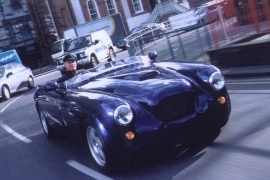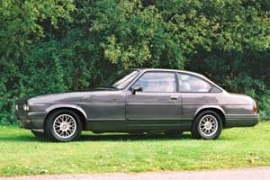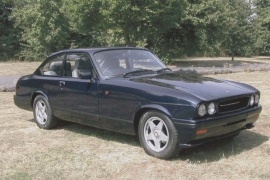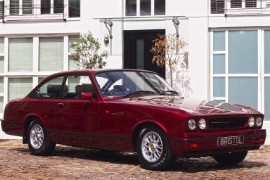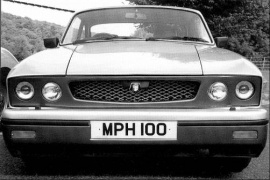BRISTOL Blenheim Models/Series Timeline, Specifications & Photos
First production year: 1994
Engines: Gasoline, Hybrid
Body style: Coupé (two-door)
The British carmaker Bristol unveiled an unusual-looking vehicle on the market in 2002: the Blenheim Speedster, but the sales started in 2004.
Bristol was still under complete UK ownership, unlike MINI, Rolls-Royce, Bentley, Aston Martin, Jaguar, or Land Rover. That made them unique, even though their cars were not entirely British anymore. The Blenheim Speedster is one example of that. It combined old technologies and design with new drivetrains. It was built on the same platform as the Blenheim four-seater, which, in turn, relied on a modified version of the box-frame chassis from the 1938 BMW 328.
The design was inspired by the former Bristol Bullet prototype from the '50s and resembled the 404 model. It featured an open "mouth" that fed cold air to the radiator. On the front fascia, the rounded fenders comprised the round headlights and the blinkers underneath them, just like on the old 404 model. But despite that classic look, the bodywork was made from aluminum, and the flush fenders and doors confirmed the modern interpretation of the old design. Moreover, the car was an open-top construction, without a greenhouse. Thus the driver and the side passenger were protected only by a short windscreen. At the back, two fins were added to the rear quarter panels. The rear bumper was concealed behind the panel, while a two-exhaust system let the engine breathe.
Since Bristol tried to offer a luxurious feeling to its customers, it fitted the open-top roadster with leather-wrapped bucket seats, separated by a center console where the automatic-transmission gear selector took place.
Unlike the 404, which featured a six-mill powerplant, the Blenheim Speedster received a 5.9-liter, Chrysler-sourced V8 engine. It was mated with a five-speed automatic transmission that sent the power to the rear wheels.
The last series product of the British car-manufacturer Bristol was the 2002 Blenheim. It was a new improvement over the original 1976 603 model, even if it wasn't the last model produced by Bristol.
The Bristol history had ups and downs. Its glory days were shared with BMW engines and even BMW shapes. That was after WWII and some vehicles even featured the BMW kidneys on the grille, but not the badge. Over time, the car manufacturer has decided to switch sides and bought the V8 engines from Chrysler.
In 1976, Zagato was employed to draw a new shape for the aged Bristol 411 Coupe. It retained the three-box design and imagined a silhouette of a 4-seats grand tourer. Its greenhouse was tall enough to accommodate comfortably two adult passengers in the rear. The car featured some modifications between 1976 and 2002, but it kept the same basics. Some slight touches here and there were made to make the car more appealing for its customers. The four rounded headlights and the redesigned grille were part of the change. In the rear, the Opel/Vauxhall Senator horizontally mounted taillights were new.
Inside, there were the same exclusive British materials. The 2002 model featured the same complicated dashboard design, inspired by the WWII aircrafts. The wood trims and the round air-vents were in total disharmony with the Radio-CD mounted on top of the center console, like it was a cheap replacement for the original equipment.
Under the hood, there was the same 5.9-liter V8 unit from Chrysler but upgraded to deliver 350 hp. It was mated to a standard 4-speed automatic transmission.
By 1999, Bristol remained one of the last British car manufacturers under British ownership, and the boutique brand struggled to survive with a new facelift for its aging Blenheim.
The nameplate was old, and the car was not a chicken spring either. And yet, Bristol managed to update the Blenheim and keep its name alive on the market. Still, there were not too many customers for this exclusive four-seat coupe that was moved by a Chrysler engine and sported an aviation-inspired interior.
Like its predecessors, the Blenheim 3 featured a four-round headlights system that made it look like a refreshed 1980s Ford Capri. Even the shape was, overall, similar. For the 1999 version, dubbed Blenheim 3, the vehicle received a new radiator grille with a chromed horizontal slat in the middle. Like its predecessors, the car's profile revealed a long hood and an unusually long distance between the front wheels and the A-pillar. At the back, the car got a new set of taillights, carried over from Opel Senator instead of the Opel Omega as before.
Inside, it was a mix of old and new designs. On one hand, the comfortable seats, the center console where the gear stick was placed, and the door cards belonged to the '90s. On the other hand, the dashboard designed in the '70s with a flat wood panel fronting the passengers and the WWII-warbirds-inspired instrument cluster were too classical. At least on top of it stood a new stereo. The cabin offered room for four adults on the front bucket seats and the rear bench.
Under the hood, there was the same 5.9-liter V8 unit from Chrysler but upgraded to deliver 350 hp. It was mated to a standard 4-speed automatic transmission. A special version, named Blenheim 3S, was available and provided more power and better brakes and suspension.
Bristol introduced the Blenheim II in 1998 as an improved version of the 603 model, which was initially launched in 1976.
At first sight, there were no significant changes for the elegant British grand tourer. And yet, some significant improvements were under the hand-crafter aluminum skin of the car. Also, the exterior was subtly revised, and the vehicle finally received a better transmission.
Keeping the same three-box sedan shape for the Blenheim was not a problem for the British carmaker. Yet, the nose and the rear end of the car were slightly reshaped for a sleeker look. At the front, the former VW Scirocco headlights were replaced with a pair of two round headlamps, and the grille was adorned with a body-colored rim. Yet, the aluminum panels were still made by hand, and the spare wheel was still placed in a compartment behind the left front fender.
The interior was still luxurious, boasting a combination of leather and wood materials, but the dashboard's design was new. Bristol also said that the car could carry four passengers comfortably and that there was enough legroom for rear passengers.
Under the skin, there were more modifications. The car's track was widened, and the suspension was reworked, reducing the turning radius by two feet (0.6 m). Moreover, the 5.9-liter V8 engine was more potent than the formerly used 5.2-liter powerplant and more fuel-efficient thanks to the new four-speed automatic transmission. Unfortunately, in an era of unibody vehicles, the Blenheim 2 still relied on a body-on-frame construction.
Bristol cars were not about creating new vehicles and charging the market with outstanding models but creating exclusive vehicles for those who appreciated British cars.
While it wasn't very keen on introducing new models, the British manufacturer still had to comply with new rules and regulations, forcing it to upgrade its vehicles to sell them. Thus, in 1994, Bristol dismissed the former Britannia model produced between 1982 and 1994 with the Blenheim. The new model took its nameplate from a former famous British bomber built during WWII.
The vehicle's overall shape was not much different than of its predecessor or even its grandfather, the Bristol 603, which was introduced in 1976. It featured the same long hood with a spare wheel hidden behind the front left fender. In addition, the Blenheim sported a front fascia with four round headlights that resembled those installed in the Ford Capri. Bristol designed the vehicle using the same three-box shape from the 603 but refined it with new, flush door handles. At the back, the corner-mounted taillights flanked the trunk's lid.
Inside, the car manufacturer counted on high-quality materials utilized for the seats, dashboard, and door panels. It used fine leather and gloss-finish wood trims for most of the panels. The British bombers inspired the dashboard's design, with a logical layout in front of the driver. But then, the design team needed to find a way to install the new audio equipment and place it atop the dashboard. So even though it didn't look delicious, it was a logical decision.
Under the hood, Bristol finally made its step into the fuel-injected era. It provided the Blenheim with a Chrysler 5.9-liter V8 paired with a four-speed automatic gearbox.
